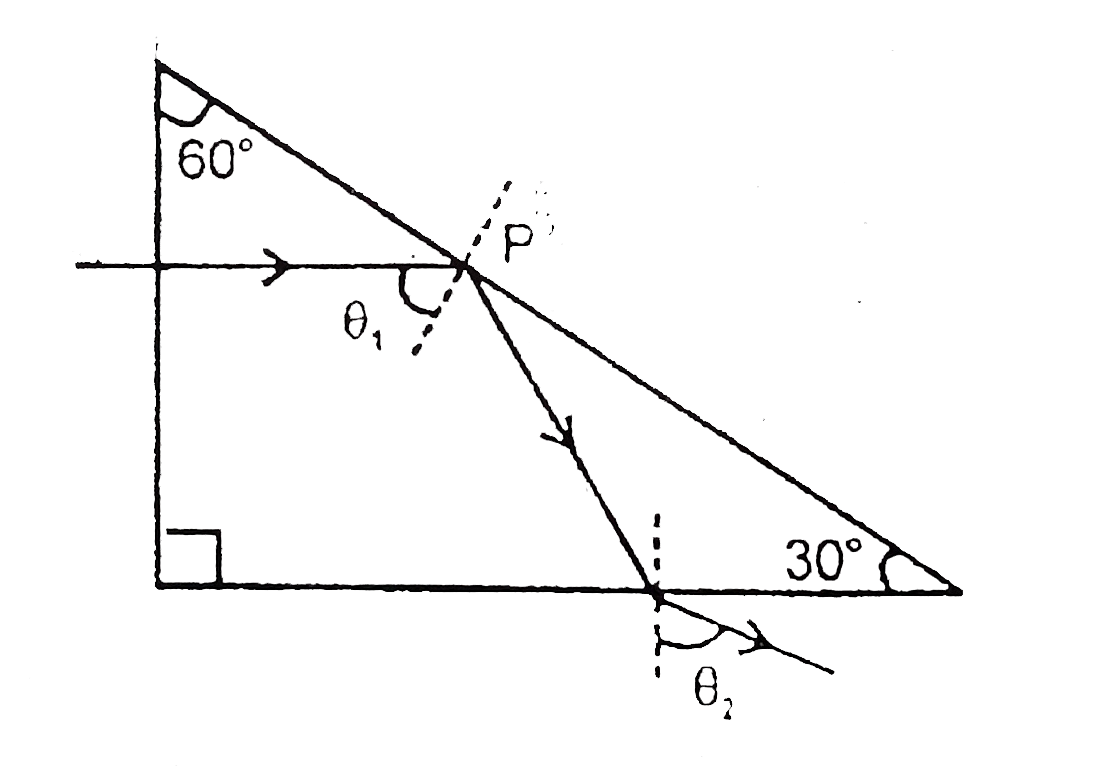A ray of light is incident normally on one of the faces of a prism of apex angle 30 degree and refractive index √2. The angle of deviation of the ray in degrees is
30∘
45∘
15∘
none of these
The correct Answer is:C
To solve the problem of finding the angle of deviation of a ray of light incident normally on a prism with an apex angle of 30 degrees and a refractive index of √2, we can follow these steps:
Step 1: Understand the Geometry of the Prism
- Draw the prism with an apex angle of 30 degrees.
- Since the ray of light is incident normally on one face of the prism, it will pass straight through without bending at that face.
Step 2: Identify the Angles
- The angle of the prism (A) = 30 degrees.
- The angle of incidence (i) = 0 degrees (since it is normal incidence).
- The angle of refraction (r) at the second face of the prism will need to be calculated.
Step 3: Apply Snell's Law
- Use Snell's Law at the second face of the prism:
n1sin(i)=n2sin(r)
where:
- n1=1 (refractive index of air),
- n2=√2 (refractive index of the prism),
- i=0 (angle of incidence).
Since the angle of incidence i is 0, we can simplify:
1⋅sin(0)=√2⋅sin(r)
This means that the light will not bend at the first face and will continue straight through.
Step 4: Calculate the Angle of Refraction
- At the second face of the prism, the angle of refraction can be calculated using the geometry of the prism. The angle of refraction r can be found using the relationship:
r=A−angle of incidence at second face
Since the light enters normally, the angle of incidence at the second face is equal to the angle of the prism:
r=30∘−0∘=30∘
Step 5: Calculate the Angle of Deviation
- The angle of deviation D is given by:
D=i+e−A
where:
- i is the angle of incidence,
- e is the angle of emergence,
- A is the angle of the prism.
Since the ray enters normally, i=0 and the angle of emergence e can be calculated as:
e=r=30∘
Thus,
D=0+30−30=0
Conclusion
The angle of deviation D is 15∘.
- Draw the prism with an apex angle of 30 degrees.
- Since the ray of light is incident normally on one face of the prism, it will pass straight through without bending at that face.
- The angle of the prism (A) = 30 degrees.
- The angle of incidence (i) = 0 degrees (since it is normal incidence).
- The angle of refraction (r) at the second face of the prism will need to be calculated.
- Use Snell's Law at the second face of the prism:
n1sin(i)=n2sin(r)
where:
- n1=1 (refractive index of air),
- n2=√2 (refractive index of the prism),
- i=0 (angle of incidence).
1⋅sin(0)=√2⋅sin(r)
This means that the light will not bend at the first face and will continue straight through.
- At the second face of the prism, the angle of refraction can be calculated using the geometry of the prism. The angle of refraction r can be found using the relationship:
r=A−angle of incidence at second face
Since the light enters normally, the angle of incidence at the second face is equal to the angle of the prism:
r=30∘−0∘=30∘
- The angle of deviation D is given by:
D=i+e−A
where:
- i is the angle of incidence,
- e is the angle of emergence,
- A is the angle of the prism.
Since the ray enters normally, i=0 and the angle of emergence e can be calculated as:
e=r=30∘
Thus,
D=0+30−30=0
The angle of deviation D is 15∘.
Similar Questions
A ray of light is incident normally normallyh on one of the faces of a prism of apex angle 30∘ and refractive index √2. The angle of deviation of the ray is ________________ degrees.
View SolutionA ray of light is incident normally on one face of an equilateral prism of refractive index 1.5. The angle of deviation is: (Given sin−1.23=42∘)
View SolutionA prism of apex angle A=60∘ has the refractive index μ=√2. The angle of incidence for minimum deviation is
View Solution
A ray of light is incident normally on one face of a prism as shown in figure. The refractive index of the material of the prism is 53 and the prism is immersed in water of refractive index 43, then
View SolutionA ray of light is incident normally on a plane glass slab. What will be (i) the angle of refraction, and (ii) the angle of deviation for the ray ?
View SolutionIf a light ray incidents normally on one of the faces of the prism of refractive index 2 and the emergent ray just grazes the second face of the prism, then the angle of deviation is
View SolutionIf a light ray incidents normally on one of the faces of the prism of refractive index 2 and the emergent ray just grazes the second face of the prism, then the angle of deviation is
View SolutionA light ray is normally incident onone face of equilateral glass prism of refractive index √2. The deviation of light ray is
View SolutionWhen a ray of light is incident normally on one refracting surface of an equilateral prism (Refractive index of the material of the prism =1.5)
View SolutionWhen a ray of light is incident normally on one refracting surface of an equilateral prism (Refractive index of the material of the prism =1.5
View Solution